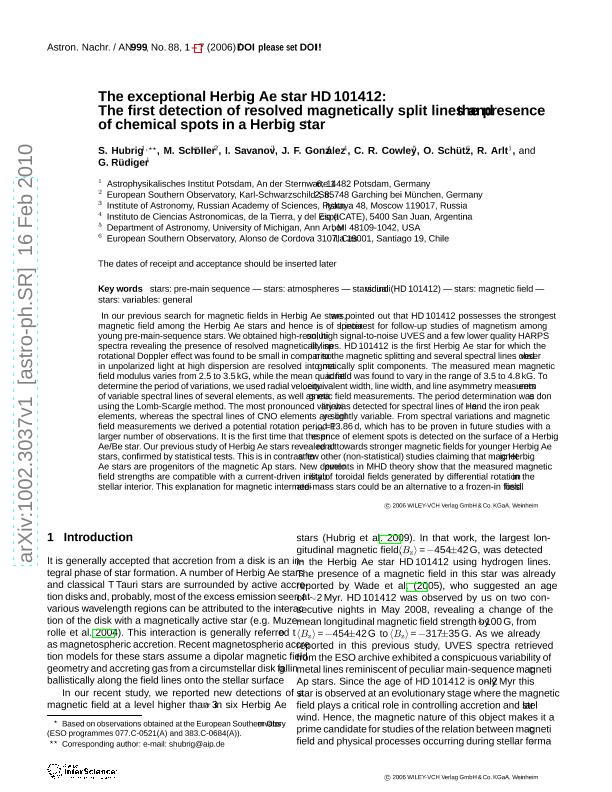Mostrar el registro sencillo del ítem
dc.contributor.author
Hubrig, S.
dc.contributor.author
Schöller, M.
dc.contributor.author
Savanov, I.
dc.contributor.author
Gonzalez, Jorge Federico

dc.contributor.author
Cowley, C. R.
dc.contributor.author
Schütz, O.
dc.contributor.author
Arlt, R.
dc.contributor.author
Rüdiger, G.
dc.date.available
2017-02-14T16:00:18Z
dc.date.issued
2010-04
dc.identifier.citation
Hubrig, S.; Schöller, M.; Savanov, I.; Gonzalez, Jorge Federico; Cowley, C. R.; et al.; The exceptional Herbig Ae star HD 101412: The first detection of resolved magnetically split lines and the presence of chemical spots in a Herbig star; Wiley Vch Verlag; Astronomische Nachrichten; 331; 4; 4-2010; 361-367
dc.identifier.issn
0004-6337
dc.identifier.uri
http://hdl.handle.net/11336/12979
dc.description.abstract
In our previous search for magnetic fields in Herbig Ae stars, we pointed out that HD 101412 possesses the strongest magnetic field among the Herbig Ae stars and hence is of special interest for follow-up studies of magnetism among young pre-main-sequence stars. We obtained high-resolution, high signal-to-noise UVES and a few lower quality HARPS spectra revealing the presence of resolved magnetically split lines. HD 101412 is the first Herbig Ae star for which the rotational Doppler effect was found to be small in comparison to the magnetic splitting and several spectral lines observed in unpolarized light at high dispersion are resolved into magnetically split components. The measured mean magnetic field modulus varies from 2.5 to 3.5 kG, while the mean quadratic field was found to vary in the range of 3.5 to 4.8 kG. To determine the period of variations, we used radial velocity, equivalent width, line width, and line asymmetry measurements of variable spectral lines of several elements, as well as magnetic field measurements. The period determination was done using the Lomb-Scargle method. The most pronounced variability was detected for spectral lines of He I and the iron peak elements, whereas the spectral lines of CNO elements are only slightly variable. From spectral variations and magnetic field measurements we derived a potential rotation period P_rot=13.86 d, which has to be proven in future studies with a larger number of observations. It is the first time that the presence of element spots is detected on the surface of a Herbig Ae/Be star. Our previous study of Herbig Ae stars revealed a trend towards stronger magnetic fields for younger Herbig Ae stars, confirmed by statistical tests. This is in contrast to a few other (non-statistical) studies claiming that magnetic Herbig Ae stars are progenitors of the magnetic Ap stars. New developments in MHD theory show that the measured magnetic field strengths are compatible with a current-driven instability of toroidal fields generated by differential rotation in the stellar interior. This explanation for magnetic intermediate-mass stars could be an alternative to a frozen-in fossil field.
dc.format
application/pdf
dc.language.iso
eng
dc.publisher
Wiley Vch Verlag

dc.rights
info:eu-repo/semantics/openAccess
dc.rights.uri
https://creativecommons.org/licenses/by-nc-sa/2.5/ar/
dc.subject
Stars: Atmospheres
dc.subject
Stars: Magnetic Fields
dc.subject
Stars: Pre Main Sequence
dc.subject
Stars: Variables
dc.subject.classification
Astronomía

dc.subject.classification
Ciencias Físicas

dc.subject.classification
CIENCIAS NATURALES Y EXACTAS

dc.title
The exceptional Herbig Ae star HD 101412: The first detection of resolved magnetically split lines and the presence of chemical spots in a Herbig star
dc.type
info:eu-repo/semantics/article
dc.type
info:ar-repo/semantics/artículo
dc.type
info:eu-repo/semantics/publishedVersion
dc.date.updated
2017-02-13T20:30:24Z
dc.journal.volume
331
dc.journal.number
4
dc.journal.pagination
361-367
dc.journal.pais
Alemania

dc.journal.ciudad
Weinheim
dc.description.fil
Fil: Hubrig, S.. Astrophysikalisches Institut Potsdam; Alemania
dc.description.fil
Fil: Schöller, M.. European Southern Observatory; Alemania
dc.description.fil
Fil: Savanov, I.. Russian Academy of Sciences. Institute of Astronomy; Rusia
dc.description.fil
Fil: Gonzalez, Jorge Federico. Consejo Nacional de Investigaciones Cientificas y Tecnicas. Centro Cientifico Tecnologico San Juan. Instituto de Ciencias Astronomicas de la Tierra y del Espacio; Argentina
dc.description.fil
Fil: Cowley, C. R.. University Of Michigan; Estados Unidos
dc.description.fil
Fil: Schütz, O.. European Southern Observatory; Chile
dc.description.fil
Fil: Arlt, R.. Astrophysikalisches Institut Potsdam; Alemania
dc.description.fil
Fil: Rüdiger, G.. Astrophysikalisches Institut Potsdam; Alemania
dc.journal.title
Astronomische Nachrichten

dc.relation.alternativeid
info:eu-repo/semantics/altIdentifier/url/http://onlinelibrary.wiley.com/doi/10.1002/asna.201011346/full
dc.relation.alternativeid
info:eu-repo/semantics/altIdentifier/url/http://dx.doi.org/10.1002/asna.201011346
Archivos asociados
